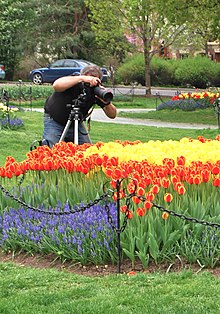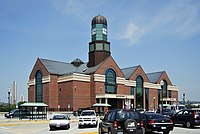
Albany County is a county in the state of New York, United States. Its northern border is formed by the Mohawk River, at its confluence with the Hudson River, which is to the east. As of the 2020 United States Census, the population was 314,848. The county seat and largest city is Albany, which is also the state capital of New York. As originally established by the English government in the colonial era, Albany County had an indefinite amount of land, but has had an area of 530 square miles (1,400 km2) since March 3, 1888. The county is named for the Duke of York and of Albany, who became James II of England.
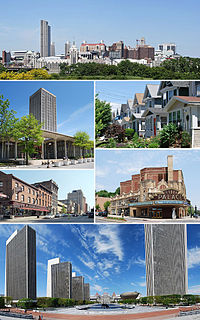
Albany is the capital of the U.S. state of New York, also the seat and largest city of Albany County. Albany is on the west bank of the Hudson River, about 10 miles (16 km) south of its confluence with the Mohawk River, and about 135 miles (220 km) north of New York City.
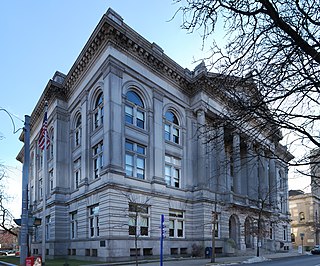
Rensselaer County is a county in the U.S. state of New York. As of the 2020 census, the population was 161,130. Its county seat is Troy. The county is named in honor of the family of Kiliaen van Rensselaer, the original Dutch owner of the land in the area.
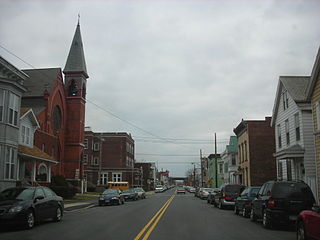
Green Island is a coterminous town-village in Albany County, New York, United States, some 8 miles (13 km) north of Albany. Green Island is one of only five such town-village amalgamations in New York. The population was 2,620 at the 2010 census, and the ZIP code is 12183. While the town of Green Island was once an island, it was connected to the mainland on the west side of the Hudson River in the 1960s.

Colonie is a town in Albany County, New York, United States. It is the most-populous suburb of Albany, and is the third-largest town in area in Albany County, occupying approximately 11% of the county. Several hamlets exist within the town. As of the 2020 census, the town had a total population of 85,590.
New York State Route 2 (NY 2) is a state highway in the Capital District of New York in the United States. It extends for 30.89 miles (49.71 km) from an interchange with Interstate 87 (I-87) and NY 7 in the town of Colonie to the Massachusetts state line in Petersburgh, where it continues to Boston as Massachusetts Route 2. The route passes through the cities of Watervliet and Troy, where it connects to NY 32 and U.S. Route 4, respectively. In Grafton, located midway between Troy and Massachusetts, NY 2 serves Grafton Lakes State Park.

The Rensselaer and Saratoga Railroad was chartered on April 14, 1832. It completed 25.2 miles (40.6 km) between Troy and Ballston Spa on March 19, 1836.

The Albany Pine Bush, referred to locally as the Pine Bush, is one of the largest of the 20 inland pine barrens in the world. It is centrally located in New York's Capital District within Albany and Schenectady counties, between the cities of Albany and Schenectady. The Albany Pine Bush was formed thousands of years ago, following the drainage of Glacial Lake Albany.
New York State Route 7 (NY 7) is a 180.30-mile-long (290.16 km) state highway in New York in the United States. The highway runs from Pennsylvania Route 29 (PA 29) at the Pennsylvania state line south of Binghamton in Broome County, New York, to Vermont Route 9 (VT 9) at the Vermont state line east of Hoosick in Rensselaer County. Most of the road runs along the Susquehanna Valley, closely paralleling Interstate 88 (I-88) throughout that road's length. Portions of the highway route near the cities of Binghamton, Schenectady, and Troy date back to the early 19th century.

The Capital District Transportation Authority (CDTA) is a New York State public-benefit corporation overseeing a number of multi-modal parts of public transportation in the Capital District of New York State. CDTA runs local and express buses, including two lines of an express bus service called BusPlus, and day-to-day management of three Amtrak stations in the Capital region–the Albany-Rensselaer, Schenectady and Saratoga Springs Amtrak stations. In 2021, the system had a ridership of 10,978,200, or about 40,200 per weekday as of the fourth quarter of 2021.

Area codes 518 and 838 are telephone area codes serving the northeasternmost part of Upstate New York in the United States. 518 was established as one of the original area codes during 1947. Area code 838 was added as an overlay during 2017. The two area codes cover 24 counties and 1,200 ZIP Codes. There are 493 landline exchanges and 100 wireless exchanges served by 47 carriers. The numbering plan area (NPA) it covers in New York State extends from the eastern Mohawk Valley to the Vermont border, and from the Canada–US border to south of Albany. The bulk of this NPA population is in the Capital District. Other cities in the NPA are Glens Falls, Plattsburgh, and Saratoga Springs.
Latham is a hamlet in Albany County, New York, United States. It is located along U.S. Route 9 in the town of Colonie, a dense suburb north of Albany. As of the 2010 census, the population was 20,736. Latham was a census-designated place in the 1970, 1980, and 1990 US Censuses, but ceased to be in the 2000 Census, then became a CDP again in 2020.
New York State Route 470 (NY 470) is an east–west state highway in the Capital District of New York in the United States. It extends for 2.91 miles (4.68 km) from an intersection with NY 9R in the town of Colonie to a junction with U.S. Route 4 (US 4) in the city of Troy. Along the way, NY 470 intersects NY 787 in Cohoes and traverses the Hudson River via the 112th Street Bridge. NY 470 was assigned in February–March 1973 and is maintained by the cities of Cohoes and Troy.
Central Avenue, in Albany, New York, is an 11-mile (5 km) stretch in Albany County, of the 16-mile Albany-Schenectady Turnpike, which runs from Lark Street in the city of Albany, westward through the towns of Colonie, New York and Niskayuna, New York, to the city of Schenectady, New York. In the city of Albany it is called Central Avenue, in Colonie it is known as Central Avenue or Albany Schenectady Road, and in Schenectady County it is called State Street. The entire route is also called Route 5.

Tech Valley began as a marketing name for the eastern part of the U.S. state of New York, encompassing the Capital District and the Hudson Valley. Originating in 1998 to promote the greater Albany area as a high-tech competitor to regions such as Silicon Valley and Boston, the moniker subsequently grew to represent the counties in New York between IBM's Westchester County plants in the south and the Canada–United States border to the north, and has since evolved to constitute both the technologically-oriented metonym and the geographic territory comprising most of New York State north of New York City. The area's high technology ecosystem is supported by technologically-focused academic institutions including Rensselaer Polytechnic Institute and the State University of New York Polytechnic Institute.

Culture in New York's Capital District, also known as the Albany metropolitan area, stretches back to the 17th century. The area has seen prominent historical events, interesting artistic creations, and unique contributions to the culture of the United States. The largest city in the area, Albany, consistently ranks high on lists of top cities/metro areas for culture, such as being 23rd in the book Cities Ranked & Rated. The Albany-Schenectady-Troy metro area ranked 12th among large metro areas, and Glens Falls ranked 12th among the small metro areas, in Sperling's Best Places, and Expansion Management gave the Albany-Schenectady-Troy area five Stars, its highest ranking, for quality of life features.

Sports in New York's Capital District are very popular, and there is a rich history of professional teams and college athletics.
The toponymies of places in New York's Capital District are a varied lot, from non-English languages such as Native American, Dutch, and German to places named for famous people or families, of either local or national fame. Also, in the early 19th century, many places in the Hudson Valley, Capital District and points west were either named or renamed after places from Classical Antiquity











